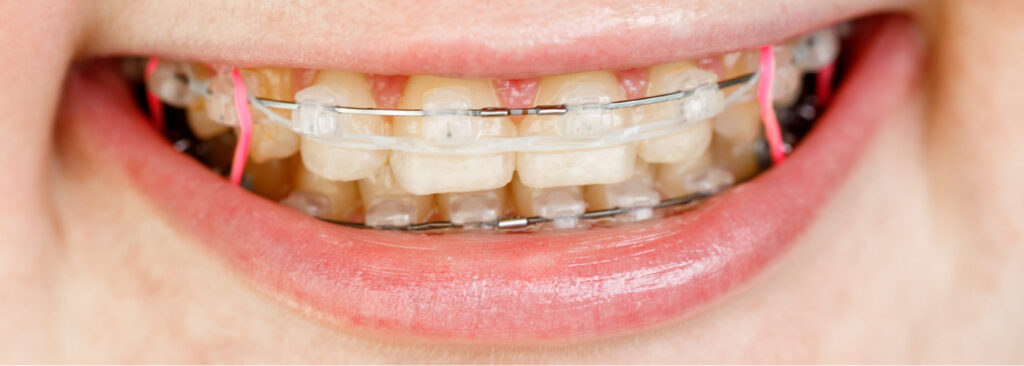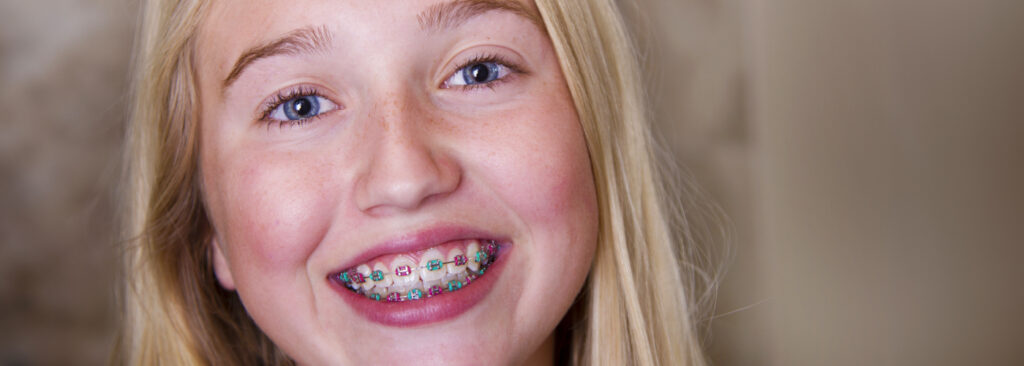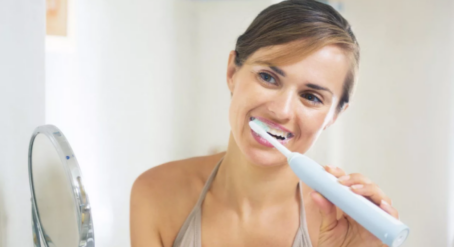Whether you have braces to correct your bite or straighten your teeth (or both), there’s a chance that you might also wear orthodontic elastics. An orthodontist might recommend these rubber bands to apply additional pressure in a specific direction to move a certain tooth or groups of teeth, which can help improve your overall bite.
And if you’re undergoing a clear alignment treatment, such as Invisalign®, Spark® and 3M Clarity®, you might wear orthodontic elastics if you need complex tooth movements or if you need your bite adjusted.
If you’ve just started wearing bands with your braces, or you’re about to embark on your teeth-straightening, bite-fixing journey, then read on to learn everything there is to know about orthodontic elastics.

What are orthodontic bands used for?
An orthodontist might add bands to your braces treatment to help align your bite during the bite-fixing phase of treatment. These bands stretch over tiny hooks on the top and bottom of your braces or over small clear buttons attached to a few teeth if you are wearing clear aligners. When you wear the elastics consistently, they will apply the steady pressure needed to guide teeth into the correct position. Not every person who gets braces will need elastics, as it depends on their existing jaw alignment and what the orthodontist recommends.
These elastics are usually crafted from medical-grade latex, which is safe to be in contact with your mouth, but latex free options are also available – and no, they are not normal elastic bands or hair bands!
Your orthodontist will show you how to wear the elastics so it will soon become second nature to replace them.
What are the different types of elastics for braces?
There are different types of elastics that your orthodontist may recommend for you or your child, which includes:
- Class I elastics close the gap between teeth. These elastics run from the upper first or second molar hook to the upper cuspid hook.
- Class II elastics reduce an overjet by retracting the upper teeth and moving the lower teeth forward.
- Class III elastics correct an underbite by retracting lower teeth and advancing upper teeth.
- Vertical elastics link the upper teeth with your lower teeth, which helps if you have an open bite.
- Front cross elastics connect the upper and lower teeth with a band that crosses over the front teeth, which helps if you have a crossbite.
Basic elastic tips
When it comes to wearing elastics, there are some important things that you should do to ensure your treatment goes smoothly.
For starters, get into the habit of carrying around extra elastics in your bag or pocket. This allows you to replace any elastics that break while you’re out and about (make sure you wash your hands first!), without having to wait until you’re home. By adopting this habit and wearing your elastics constantly, you can keep up the progress on your orthodontic treatment.
Having said that, it’s important that you don’t put too many bands on your tooth. While it may seem like a good idea, putting more than one band on your tooth can result in too much pressure, which may not be beneficial for your treatment. If you feel that the elastics are not strong enough, it is better to first consult your orthodontist.
If you find yourself low on bands, then contact your orthodontic clinic. When you first get your bands, your orthodontist will usually give you plenty of elastics to keep you going for some time. But if you need more, they’ll be happy to give you a top-up.
Lastly, you must only ever use elastics provided by your orthodontist. Never use elastics sourced from other places as they may not be right for you and can interfere with your treatment.

How to put elastics on your braces
Learning how to put elastics on and take them off is essential for most patients undergoing braces or clear aligner treatment.
Before getting started with elastics, your orthodontist will give you instructions on how to apply your elastics based on your unique treatment needs.
Rubber bands are usually attached to the hooks on braces or aligners so make sure you know the different parts of your braces or aligners before attempting to use these bands. Again, you can ask your orthodontist for additional guidance if you think that will help.
Change your rubber bands as instructed by your orthodontist and ensure you are wearing them for the correct amount of time so that the right amount of pressure is applied. You may need to change your bands more than three times a day depending on your bite.
Attend your regular orthodontic appointments to ensure your treatment stays on track and the necessary elastic adjustments take place.
What if you can’t get your elastics back on?
If for whatever reason you’re struggling to get your elastic bands back onto your teeth, the first thing you should do is to stay calm! While it can feel overwhelming when you can’t put your elastics back on, there are couple of things you can do before contacting your orthodontist as a last resort.
Check your elastics packet to see if there are any instructions or guides somewhere that show how you’re meant to put the elastics on. If your packet does have a diagram, then take a photo of it on your phone so you’ve always got a guide on-hand.
If you’re prone to shaky hands when putting on your bands, then consider trying to place your elastics with sweezers or ask your orthodontist for an elastic placer. These small tools have two different shaped hooks on either end that hook around the elastic that you then can take off or put on.
Do rubber bands on braces hurt?
It’s normal to feel some discomfort when using rubber bands with your braces at the start. This is because these bands place additional pressure on your teeth and jaws to ensure they move into the correct position. This pain should not last long.
But if you want some relief from discomfort, you should try taking over-the-counter pain relief medication per your orthodontist’s instructions. If you continue to feel pain or discomfort, it’s best to call your specialist orthodontist who will ensure the rubber bands are fitted properly and pain is minimised.
How long do you need to wear your elastic bands?
The time you will spend with elastics will vary depending on your specific treatment needs – from two months to over a year.
It’s important to wear your elastics full-time (or as instructed) to ensure your treatment stays on track and completion is not delayed. Unless specified differently by your orthodontist, the only time to remove your elastics is when brushing your teeth, eating and when replacing old elastics with new ones.
What if you run out of elastics between appointments?
If your supply is running low or you are completely out of bands, don’t panic. Simply give your orthodontist a call and they will give you more elastics or tell you what to do. There will be a record of the type of elastics you need, and how you are supposed to wear them, in your treatment file, but it’s a good idea to make a note just in case. Don’t ask to borrow elastics from friends as chances are they won’t have the same type or size as you.
As the type and size of elastics you are wearing would be recorded, you can usually pick some up from the patient reception desk at the practice or even have them mailed to you if this is more convenient.
What happens if you skip a day of elastics?
While there won’t be much of a change to your treatment if you don’t wear your elastics for a day, it’s important that you put them back on as soon as possible. The longer you go without your elastics, the more likely your treatment will need to be extended and it’ll be harder to get the perfect smile.
How many hours do elastics last?
Orthodontic elastics can last for up to 24 hours, however, it’s important that you change them as instructed by your orthodontist.
Is it okay to eat with elastics?
If you’re eating foods that do not require that you open your mouth very wide, then you may be able to eat those foods with your elastics on. But if you need to eat something and feel like your elastics will get in the way, then you can remove them for a short period of time and replace them after you’ve brushed your teeth or straight after the meal itself. If you take your elastics out any longer, then you’re putting your orthodontic treatment at greater risk of becoming delayed. So, it’s important to make sure the elastics are attached to your braces as often as possible.
Can I brush my teeth with elastics?
No, you cannot brush your teeth when you’ve got elastics on. It’s important that you take off your elastics before brushing and flossing your teeth.

Ready to start your orthodontics journey?
If you think you or your child needs to see an orthodontist, then you can use our Finder Tool to discover a local specialist orthodontist near you. The Finder Tool also allows you to request a consultation at your local specialist, so you can kick-start you or your child’s orthodontics journey.













I’m planning to get my braces done but my orthodontist told me I only need my top one done although I need to pull two teeth down how is this going to work?
Hi Jennifer, It can be difficult to comment on the specifics of a case without a consultation. If you’re unsure about their treatment recommendation you can seek a second opinion from a different orthodontist, and if they recommend the same treatment you can ask them to explain in more detail how your treatment will progress and what outcomes you can expect. Click here to check you’re seeing a specialist orthodontist, or to find a registered orthodontist near you.
i have a band in on my braces but It keeps breaking and i swollow the band is there a way to stop this?
It is best to talk to your orthodontist if you’re experiencing difficulties with your elastic bands to ensure your treatment progresses as expected. However, you can also see if there are any behaviours you can adjust to keep your elastics in tact. This can include removing them while eating and brushing your teeth, and trying not to open your mouth too widely.
Nice lesson
I got vertical elastics (canine to canine) and I’m wondering what would happen if I just don’t wear them? as I cant deal with the pain and discomfort so what would be best to do? like if I dont wear the elastics will my teeth still come in place it will just take longer?
Hi Chloe, if you don’t wear your elastics then your teeth won’t be directed to come down into the position you want and it will likely extend your treatment significantly. However, you should speak to your orthodontist about your concerns and any issues you’re having with your treatment to ensure you get their specialist opinion.
Hi, I have been wearing braces for 3 years now due to malocclusion with cross bite. I noticed that I also have open gingival embrasures. Can it be corrected using braces or do I need another procedure for it?
Hi Faith,
Your orthodontist will be able to advise if the open gingival embrasures can be closed. Sometimes this is possible with some IPR (interproximal reduction) if it is related to the shape of the teeth.
Thanks!
Hi, I’m currently in the first few weeks of my Invisalign journey and I’m 25 years old, I was quite upset at the process with my dentist as it was very fast and he didn’t give me any pros and cons to the treatment, I also have a overjet/overbite and he didn’t say I could fix this. Is this true?
I’ve read others who are older than me who have overbite and have done elastics with brazes. Thanks
You can access our Finder Tool to search for an orthodontist here: https://finder.orthodonticsaustralia.org.au/